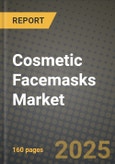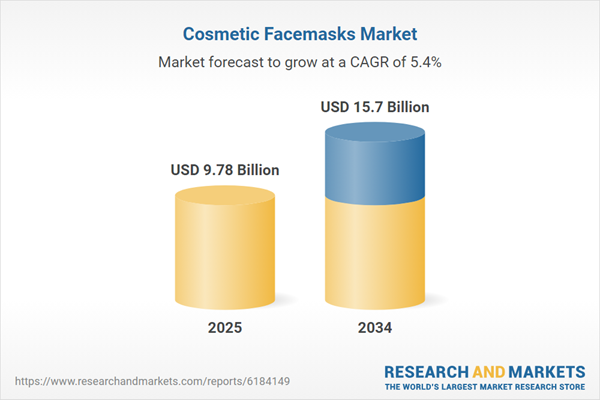Cosmetic Facemasks Market
The Cosmetic Facemasks Market is shifting from episodic pampering to a science-backed, routine skincare step, spanning sheet, hydrogel, clay/mud, peel-off, overnight sleeping masks, and smart device-assisted formats. Adoption is propelled by self-care culture, derm-inspired actives, and social content that rewards instant, photogenic results. Core end uses include hydration and barrier repair, exfoliation and brightening, oil control and acne care, anti-aging and firming, and post-procedure soothing. Brands compete on clinically credible actives (HA, ceramides, niacinamide, vitamin C, PHA/AHA/BHA), biocellulose and hydrogel substrates for occlusion and delivery, and sensorial cues - cooling, aromatics, and mess-free removal. Packaging is evolving toward mono-material films, dry masks activated at home, and refillable jars to reduce waste; device ecosystems pair masks with microcurrent, LED, or sonic infusion for premiumization. Retail is omnichannel: DTC, specialty beauty, pharmacies, travel retail, and social commerce; minis and multi-packs enable trial and subscription replenishment. Regulatory focus on claims substantiation, preservative profiles, and fragrance allergens elevates documentation and testing rigor. Supply chains prioritize substrate quality, serum viscosity control, and clean-room filling, while ingredient transparency and microbiome-friendly positioning build trust. Professional channels and derm clinics endorse post-treatment masks for immediate comfort and barrier support, reinforcing at-home adoption. Overall, the category is professionalizing around efficacy, skin-type specificity, and sustainability without sacrificing sensorial delight - positioning masks as high-impact, low-effort boosters that amplify core routines, drive repeat purchase through visible results, and anchor brand ecosystems across price tiers and regions.Cosmetic Facemasks Market Key Insights
- Clinical credibility over novelty. Efficacy drives loyalty: data-backed actives, controlled pH, and occlusive delivery outperform gimmicks, with consumer testing and before/after evidence now central to launches.
- Substrate science matters. Biocellulose and hydrogel offer superior adherence and fluid handling; breathable cotton and lyocell win on comfort and sustainability, while dry-to-wet masks reduce preservatives.
- Barrier-first positioning. Ceramides, cholesterol, fatty acids, and HA blends shift narratives from quick fixes to barrier repair, sensitive-skin safety, and post-procedure compatibility.
- Textural differentiation. Rinse-free sleeping masks, jelly and pudding textures, and quick-set clays deliver convenience and sensorial payoff, expanding beyond traditional sheets.
- Device-enabled premiumization. LED, microcurrent, and sonic infusion pairings increase perceived potency and justify higher price points through regimen ecosystems and app guidance.
- Microbiome-aware and fragrance-smart. Lower fragrance loads, allergen transparency, and pre/pro/postbiotic stories broaden appeal to reactive skin without losing sensorial cues.
- Sustainability under scrutiny. Mono-material sachets, recycled content, concentrated formats, and refillables address waste concerns while maintaining sterility and shelf life.
- Occasion-based merchandising. Jet-lag, pre-event glow, post-workout calm, and overnight recovery capsules create discoverable rituals and drive basket building with minis and multi-packs.
- Derm + spa convergence. Clinic-grade soothing masks and esthetician protocols inform retail SKUs, elevating trust and cross-selling with actives serums and sunscreens.
- Social commerce flywheel. Masking lends to shareable visuals; creator partnerships and live demos compress discovery, education, and conversion into one scroll.
Cosmetic Facemasks Market Reginal Analysis
North America
Demand is anchored by wellness culture and clinical skincare, with strong traction for barrier-repair sleeping masks, acne-control clays, and brightening sheets. Retailers emphasize claim substantiation, clean-ingredient lists, and sensitive-skin variants. Subscription boxes and multi-packs drive discovery; dermatology ties and post-procedure SKUs build credibility. Sustainability expectations push mono-material packaging and refillable gel formats. Ingredient transparency, allergen disclosure, and fragrance-reduced options expand reach across pharmacies, specialty beauty, and DTC channels.Europe
Regulatory discipline shapes conservative claims and rigorous safety documentation. Consumers prefer minimalist formulas, low fragrance, and verified eco-credentials, favoring lyocell and biocellulose substrates. Pharmacies and derm chains lead education on active concentrations and tolerability. Recyclable sachets and concentrated overnight masks align with waste-reduction goals. Spa and thalassotherapy traditions inspire alginate and marine-active masks, while colder climates sustain demand for lipid-rich night masks and winter repair kits.Asia-Pacific
Category origin strength fuels rapid innovation in substrates, essences, and sensorial cues. Korea and Japan drive thin, high-adherence sheets, ampoule-level serums, and device pairings; Australia and Southeast Asia prioritize oil-control and cooling masks for humid climates. China’s social commerce powers limited runs, IP collabs, and value multi-packs. Ingredient stories spotlight fermented actives and gentle acids. Travel retail and convenience chains expand impulse buys; refill bars and recyclable cartons emerge in premium doors.Middle East & Africa
Climate and skin concerns steer interest toward hydration, soothing, and pigment-uniformity masks, with cooling gels and fragrance-conscious formulas preferred. Prestige retail in tourism hubs accelerates premium adoption, while pharmacies expand derm-led options. Import dependence elevates distributor partnerships and in-market education on layering with sunscreens and retinoids. Single-use waste is a talking point; higher-capacity jars and multi-use sleeping masks gain visibility alongside hygienic spatulas.South & Central America
Vibrant beauty culture supports sensorial, glow-forward masks and acne/oil-control clays. Affordability and value packs drive volume through drugstores and marketplaces, while derm channels introduce barrier-repair night masks for sensitive skin. Local botanicals - cacay oil, Amazonian clays - differentiate storytelling. Heat and humidity shape rinse-free, lightweight textures and post-sun soothing formats. Sustainability narratives emphasize recyclable sachets and concentrated gels that reduce shipping weight without compromising experience.Cosmetic Facemasks Market Segmentation
By Type
- Anti Aging
- Hydrating
- Whitening
- Others
By Skin
- Oily Skin
- Dry Skin
- Others
By Form
- Sheet
- Clay
- Gel
- Cream
- Even spray/foam
By Distribution Channel
- Online
- Offline
Key Market players
L’Oréal, The Estée Lauder Companies, Shiseido, Amorepacific, LG Household & Health Care, Unilever, Johnson & Johnson (Neutrogena), Beiersdorf, Kao Corporation, KOSÉ Corporation, Rohto Pharmaceutical (Hada Labo), L&P Cosmetic (Mediheal), Tonymoly Co., Ltd., Shanghai Jahwa United (Pechoin), Mary Kay Inc.Cosmetic Facemasks Market Analytics
The report employs rigorous tools, including Porter’s Five Forces, value chain mapping, and scenario-based modelling, to assess supply-demand dynamics. Cross-sector influences from parent, derived, and substitute markets are evaluated to identify risks and opportunities. Trade and pricing analytics provide an up-to-date view of international flows, including leading exporters, importers, and regional price trends.Macroeconomic indicators, policy frameworks such as carbon pricing and energy security strategies, and evolving consumer behaviour are considered in forecasting scenarios. Recent deal flows, partnerships, and technology innovations are incorporated to assess their impact on future market performance.
Cosmetic Facemasks Market Competitive Intelligence
The competitive landscape is mapped through proprietary frameworks, profiling leading companies with details on business models, product portfolios, financial performance, and strategic initiatives. Key developments such as mergers & acquisitions, technology collaborations, investment inflows, and regional expansions are analyzed for their competitive impact. The report also identifies emerging players and innovative startups contributing to market disruption.Regional insights highlight the most promising investment destinations, regulatory landscapes, and evolving partnerships across energy and industrial corridors.
Countries Covered
- North America - Cosmetic Facemasks market data and outlook to 2034
- United States
- Canada
- Mexico
- Europe - Cosmetic Facemasks market data and outlook to 2034
- Germany
- United Kingdom
- France
- Italy
- Spain
- BeNeLux
- Russia
- Sweden
- Asia-Pacific - Cosmetic Facemasks market data and outlook to 2034
- China
- Japan
- India
- South Korea
- Australia
- Indonesia
- Malaysia
- Vietnam
- Middle East and Africa - Cosmetic Facemasks market data and outlook to 2034
- Saudi Arabia
- South Africa
- Iran
- UAE
- Egypt
- South and Central America - Cosmetic Facemasks market data and outlook to 2034
- Brazil
- Argentina
- Chile
- Peru
Research Methodology
This study combines primary inputs from industry experts across the Cosmetic Facemasks value chain with secondary data from associations, government publications, trade databases, and company disclosures. Proprietary modeling techniques, including data triangulation, statistical correlation, and scenario planning, are applied to deliver reliable market sizing and forecasting.Key Questions Addressed
- What is the current and forecast market size of the Cosmetic Facemasks industry at global, regional, and country levels?
- Which types, applications, and technologies present the highest growth potential?
- How are supply chains adapting to geopolitical and economic shocks?
- What role do policy frameworks, trade flows, and sustainability targets play in shaping demand?
- Who are the leading players, and how are their strategies evolving in the face of global uncertainty?
- Which regional “hotspots” and customer segments will outpace the market, and what go-to-market and partnership models best support entry and expansion?
- Where are the most investable opportunities - across technology roadmaps, sustainability-linked innovation, and M&A - and what is the best segment to invest over the next 3-5 years?
Your Key Takeaways from the Cosmetic Facemasks Market Report
- Global Cosmetic Facemasks market size and growth projections (CAGR), 2024-2034
- Impact of Russia-Ukraine, Israel-Palestine, and Hamas conflicts on Cosmetic Facemasks trade, costs, and supply chains
- Cosmetic Facemasks market size, share, and outlook across 5 regions and 27 countries, 2023-2034
- Cosmetic Facemasks market size, CAGR, and market share of key products, applications, and end-user verticals, 2023-2034
- Short- and long-term Cosmetic Facemasks market trends, drivers, restraints, and opportunities
- Porter’s Five Forces analysis, technological developments, and Cosmetic Facemasks supply chain analysis
- Cosmetic Facemasks trade analysis, Cosmetic Facemasks market price analysis, and Cosmetic Facemasks supply/demand dynamics
- Profiles of 5 leading companies - overview, key strategies, financials, and products
- Latest Cosmetic Facemasks market news and developments
Additional Support
With the purchase of this report, you will receive:- An updated PDF report and an MS Excel data workbook containing all market tables and figures for easy analysis.
- 7-day post-sale analyst support for clarifications and in-scope supplementary data, ensuring the deliverable aligns precisely with your requirements.
- Complimentary report update to incorporate the latest available data and the impact of recent market developments.
This product will be delivered within 1-3 business days.
Table of Contents
Companies Mentioned
- L’Oréal
- The Estée Lauder Companies
- Shiseido
- Amorepacific
- LG Household & Health Care
- Unilever
- Johnson & Johnson (Neutrogena)
- Beiersdorf
- Kao Corporation
- KOSÉ Corporation
- Rohto Pharmaceutical (Hada Labo)
- L&P Cosmetic (Mediheal)
- Tonymoly Co. Ltd.
- Shanghai Jahwa United (Pechoin)
- Mary Kay Inc.
Table Information
| Report Attribute | Details |
|---|---|
| No. of Pages | 160 |
| Published | November 2025 |
| Forecast Period | 2025 - 2034 |
| Estimated Market Value ( USD | $ 9.78 Billion |
| Forecasted Market Value ( USD | $ 15.7 Billion |
| Compound Annual Growth Rate | 5.4% |
| Regions Covered | Global |
| No. of Companies Mentioned | 15 |









